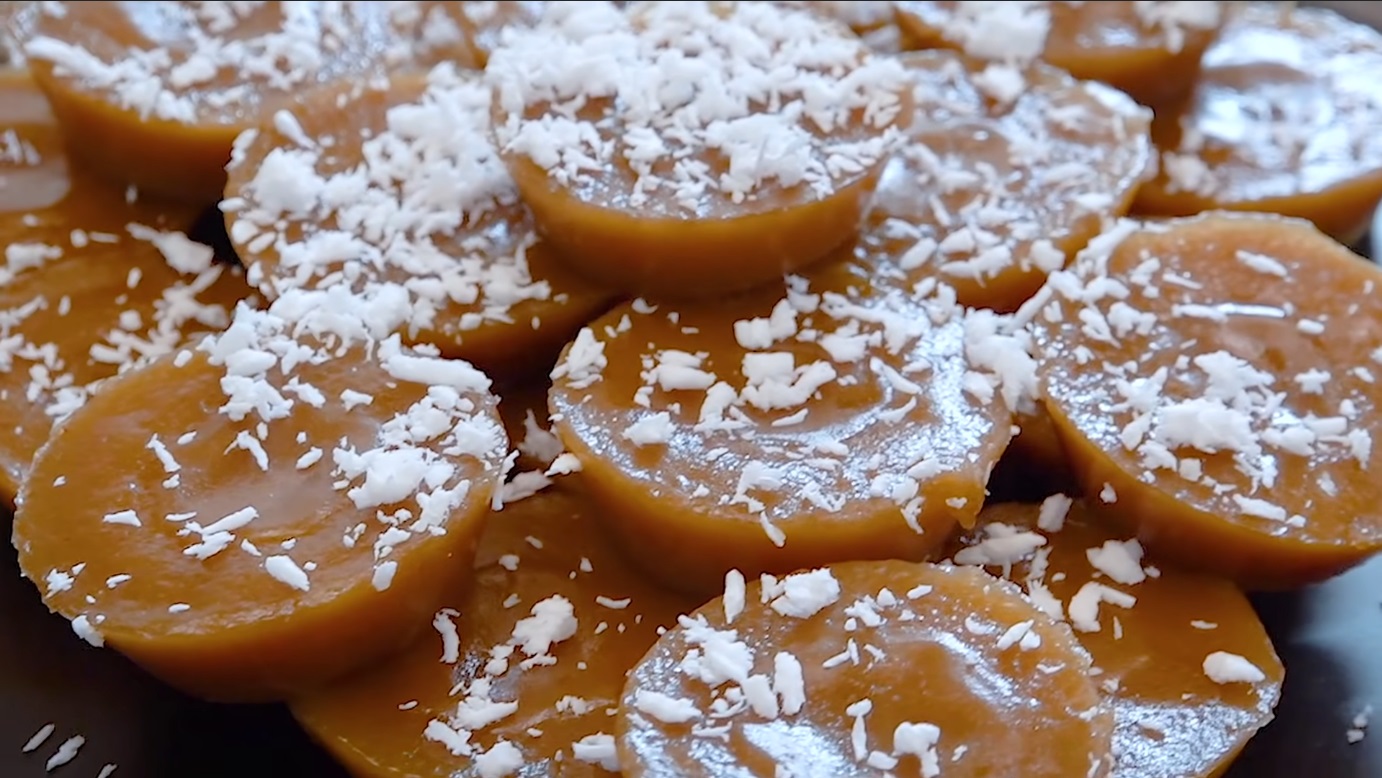Kuchinta, also spelled as kutsinta, is a popular Filipino steamed rice cake known for its chewy texture and slightly sweet flavor. Its deep amber hue, which comes from brown sugar, gives it an appealing look that makes it a staple in Filipino snack time. Often served with freshly grated coconut, Kuchinta is a delightful treat that can be enjoyed any time of the day.
Ingredients Needed for Kuchinta

Essential ingredients for the classic Kuchinta recipe:
- Rice flour: 2 cups – Essential for the structure and texture of Kuchinta. Opt for finely ground rice flour to achieve a smooth, uniform batter.
- Brown sugar: 1 cup – Provides the characteristic sweetness and deep caramel flavor. Light or dark brown sugar can be used depending on your taste preference.
- Lye water (kansui): 2 tablespoons – This traditional ingredient is crucial for achieving the chewy texture. It’s available at Asian grocery stores and online. Be cautious with the quantity, as it affects the final texture and flavor.
- Water: 2 cups – Used to dissolve the rice flour and sugar. Adjust the amount if needed to achieve the right batter consistency.
- Annatto powder: 1 tablespoon – Adds the signature orange color to Kuchinta. For a more natural alternative, use annatto seeds steeped in hot water and strained.
- Grated coconut: 1 cup – Enhances the texture and flavor. Toasting the coconut slightly can add extra depth of flavor.
Must-have kitchen tools for making Kuchinta:
- Steamer or steaming setup
- Silicone molds (traditionally round and small)
- Mixing bowl
- Whisk
- Measuring cups for accuracy
Fine-mesh strainer for a smoother batter
Step-by-Step Guide: How to Make Kuchinta

Step 1: Prepare the Ingredients
Start by gathering all your ingredients to make the process smooth. In a large mixing bowl, combine 1 cup of rice flour, 1/2 cup of tapioca flour, and 1 cup of brown sugar. These three ingredients are the base of your Kuchinta. To ensure a smooth mixture, whisk the dry ingredients together well before adding any liquids.
Next, gradually add 2 cups of water into the mixture while whisking constantly. Pour the water slowly, a little at a time, to help the ingredients blend smoothly without forming lumps. Whisk until the mixture is well combined and smooth, making sure that no dry flour remains in the bowl. This step is essential for achieving a silky batter that will result in perfectly smooth Kuchinta.
Step 2: Mix the Batter
Now it’s time to add the special ingredients that give Kuchinta its distinctive color and texture. Mix in 1 teaspoon of annatto powder. Annatto adds the traditional amber hue to your Kuchinta, giving it that beautiful, appetizing look.
After that, add 1 teaspoon of lye water. Lye water is a key ingredient that gives Kuchinta its signature chewy texture. If you can’t find lye water, you can substitute it with a solution made from 1/4 teaspoon of baking soda mixed with 1 tablespoon of water, though it might slightly alter the texture.
Stir the batter thoroughly until the annatto powder and lye water are evenly distributed throughout the mixture. The batter should be smooth and free of lumps. If needed, you can strain the batter through a fine-mesh sieve to catch any remaining lumps. This ensures that your final product will have a nice, even texture.
Step 3: Steam the Kuchinta
Once your batter is ready, prepare your silicone molds by lightly greasing them with a bit of oil. This helps prevent the Kuchinta from sticking to the molds, making it easier to remove them after steaming. Pour the prepared batter into the molds, filling each one up to about 3/4 full. This gives the batter room to expand slightly as it steams.
Set up your steamer, making sure the water is boiling before placing the molds inside. Carefully place the filled molds into the steamer, ensuring they don’t touch each other to allow for even cooking. Cover the steamer with a lid wrapped in a clean cloth or a kitchen towel to prevent steam droplets from falling onto the batter, which can cause an uneven texture on top.
Steam the Kuchinta over medium heat for 15-20 minutes or until they are firm and set. To check for doneness, gently press the center of one of the cakes—it should feel firm but slightly springy. Avoid opening the steamer too often during the process, as this can cause a loss of heat and may affect the steaming time.
Step 4: Cool and Serve
After steaming, turn off the heat and let the Kuchinta sit in the steamer for about 5 minutes. This helps them firm up a bit more and makes them easier to handle. Carefully remove the molds from the steamer using tongs or a cloth to avoid burning your hands.
Let the Kuchinta cool completely before attempting to remove them from the molds. This cooling time allows the cakes to firm up, making it easier to pop them out without breaking their shape. Once cooled, gently run a small knife or spatula around the edges to help release them.
To serve, arrange the Kuchinta on a plate and top them with freshly grated coconut. The coconut not only adds a layer of flavor but also provides a nice contrast to the chewy texture of the cakes. Enjoy your homemade Kuchinta as a snack or a dessert with a hot cup of tea or coffee!
Tips for perfect kuchinta

Achieving the Ideal Texture and Consistency
The key to Kuchinta’s signature chewy texture lies in the addition of lye water. This ingredient is what gives Kuchinta its slightly bouncy and chewy consistency, setting it apart from other types of rice cakes. However, it’s crucial to measure the lye water precisely—too much can result in an overly firm texture, while too little might make the Kuchinta too soft. Typically, 1 teaspoon of lye water is sufficient for most recipes, but always double-check based on the recipe you’re following.
To ensure even texture throughout, thoroughly mix the batter after adding the lye water. Stir continuously until you achieve a smooth, lump-free batter. Straining the batter through a fine-mesh sieve before pouring it into the molds can help remove any remaining lumps, ensuring that each piece of Kuchinta is smooth and consistent.
Perfecting the Color and Flavor
Annatto powder gives Kuchinta its characteristic amber-orange color. You can adjust the amount of annatto powder according to your personal preference. If you want a deeper, richer color, add a bit more powder. For a lighter shade, use a smaller amount. Usually, 1 teaspoon is a good starting point, but you can experiment to match your desired hue.
For those who prefer a more natural approach, you can use annatto seeds instead of the powdered form. To use annatto seeds, soak them in warm water for about 15-20 minutes, then strain out the seeds, using the colored water as a substitute for the powder. This method offers a more subtle and earthy flavor compared to annatto powder, and you can adjust the soaking time to deepen the color if needed.
Choosing the Right Mold Options
The choice of mold plays a big role in shaping your Kuchinta. Traditionally, small, round molds are used, giving Kuchinta their signature look. But you don’t need to stick strictly to tradition—silicone molds or even cupcake liners can work just as well. Silicone molds are especially convenient since they are flexible, making it easier to pop out the steamed cakes without breaking them.
Regardless of the type of mold you choose, it’s important to grease them well before pouring in the batter. Lightly brushing the molds with cooking oil helps prevent the Kuchinta from sticking, ensuring they come out smoothly after steaming. This small step can make a big difference in the final presentation of your Kuchinta, allowing you to serve beautifully shaped cakes without the frustration of them sticking to the mold.
Conclusion
Kuchinta is a delicious and easy-to-make Filipino delicacy that brings a taste of tradition right to your kitchen. Whether you’re a seasoned cook or new to Filipino cuisine, this recipe is sure to delight your taste buds. So gather your ingredients, fire up your steamer, and enjoy the sweet, chewy goodness of homemade Kuchinta!
FAQ
What is the difference between Kuchinta and Puto?
While both are steamed rice cakes, Kuchinta has a chewy texture and is often darker due to brown sugar, while Puto is lighter and fluffier.
Why is my Kuchinta not setting properly?
This may happen if you didn’t add enough lye water or if the batter wasn’t mixed well.
Can I use rice flour instead of all-purpose flour?
Yes, rice flour is actually the traditional choice for Kuchinta, contributing to its chewy texture.
How long does it take to steam Kuchinta?
Typically, it takes about 15-20 minutes over medium heat.
What can I serve alongside Kuchinta?
Kuchinta pairs well with other Filipino delicacies like bibingka or puto, offering a variety of textures and flavors.

